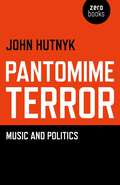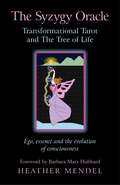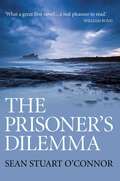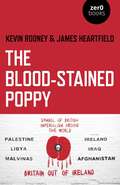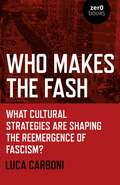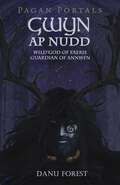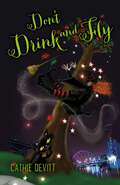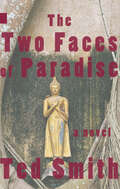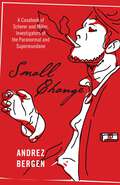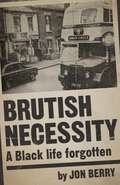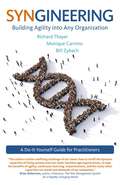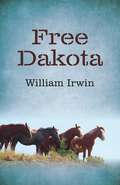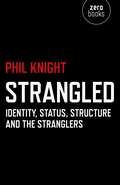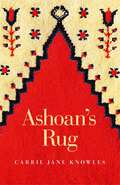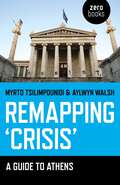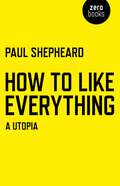- Table View
- List View
F.M.R.L.: Footnotes, Mirages, Refrains and Leftovers of Writing Sound
by Daniela CascellaListening into writing, reading into writing take shape in F.M.R.L. through a collection of short texts, fragments and &‘deranged essays&’, with attention to pacing and linguistic derives. An archive of books, notebooks, events and records prompts the texts in these pages, responding to encounters with Michel Leiris&’s autobiographical fictions; concerts and events at Café Oto and the Swedenborg House in London; visits to museums such as the Pitt Rivers in Oxford and exhibitions such as Ice Age Art at the British Museum, among the others. F.M.R.L. is a book constructed across sonic patterns, assonance, repetitions, comprising texts that intermittently drift from sense to sound and to nonsense and back. A flip from the immateriality of sound to the sounds of letters and words as material, a call from reading to voicing.
Pantomime Terror: Music and Politics
by John HutnykPantomime is a theatrical form that has come to rule our everyday lives as terror. In the early years of the 21st century, a dissembling political demonology has sometimes placed otherwise merely lyrical musicians in a volatile predicament. The discussion here is of Fun-da-Mental's Aki Nawaz portrayed as a "suicide rapper", Asian Dub Foundation striking poses from the street in support of youth in Paris and Algiers, and M.I.A., born free fighting immigration crackdown with atrocity video. Along the way, bus bombs, comedy circuits, critical theory, Arabian Nights, Bradley Wiggins, Dinarzade, Karl Marx, Paris boulevards, Molotov, Mao, the Eiffel Tower, reserve armies, lists, Richard Wagner, Samina Malik, Slavoj Zizek, Freudian slips, red-heads, Guantanamo. The book offers some sharp critiques of our contemporary complacency, and the failures of theory as more than ten years of war on terror turns anxiety at home and drone-strike assassinations abroad into a normal everyday. This pantomime is a terror story told over and over to distract from the workings of a despotic power. The need for an adequate (winning) counter-narrative was never more clear.
Syzygy Oracle - Transformational Tarot and The Tree of Life: Ego, Essence and the Evolution of Consciousness
by Heather MendelSyzygy? Jung used the term to describe the balancing of the opposites. Astronomically, syzygy (pronounced si-zi-gee) refers to a specific conjunction of the sun, moon and earth. On Mother Earth, the planet we call home, we are profoundly influenced by the radiance of the sun as well as the reflected light of the moon as we walk between light and darkness, physically and metaphorically. Solar energy evolves the ego and lunar energy evolves our essence. We learn the balance the two as we travel the twenty-two pathways of Kabbalah's Tree of Life. Honoring The Sacred Feminine, the spiritual practice offered here is an invitation to recognize and welcome intuitive wisdom more definitively into everyday awareness. A fresh interpretation of the traditional Major Arcana for women, here the patriarchal layering of the cards is lifted to reveal a timeless and timely revelation of intuitive wisdom in a sequence of insightful, profound, and empowering teachings for any woman who wishes to read her own life story as more substantive than superficial. Twenty-two of these cards reinterpret the Tarot's Major Arcana. Aligning the cards with the twenty-two letters of the Hebrew alphabet, we access three levels of soul consciousness, in Hebrew known as nefesh, ruach and neshamah through the specific letter, number and story of each card. Meet inspirational archetypes from world culture to light the way. Through meditations and mantras, discover your personal hero's journey that is a crucial part of evolving consciousness.Ten additional cards representing the sefirot or energy centers, offer the Tree of Life as an experiential introduction to Kabbalah. Coincidence and kabbalah, symbols and synchronicities, metaphors and mantras enrich and deepen life's experience. This mythic and metaphoric interpretation liberates these cards solely from the realm of prognostication and presents a meditative and inspirational tool for a daily personal practice. Heather Mendel's elegant, powerful images, full of mystery and complexity, will forever change the way you view the wisdom of the ancient Tarot.
Prisoner's Dilemma
by Sean Stuart O'ConnorThe far north coast of Scotland. Spring 1745. It begins with a murder. But is it a murder when someone is forced to kill his brother, so that he might save his own life? The guilty man is a nobody, a poor fisherman. The person who arrogantly and unthinkingly makes him commit this terrible act, simply to see how he behaved, is the richest man in Scotland, the Earl of Dunbeath. Dunbeath invents his game of life the Prisoner s Dilemma. He invites his old friend, David Hume, to Caithness to play the new game with him. But into their planned discussions blow two survivors from a shipwreck - the beautiful and brilliant Sophie Kant and the calm, charismatic captain, Alexis Zweig. What follows is a claustrophobic and fast-moving game of cat and mouse, as the characters drive relentlessly towards their destinies in life and death, love and betrayal and the passion they each have to achieve their different ambitions. Under the game-playing, the deceits and feints, the science and the philosophy, is a simple tale of three utterly determined and ruthless men struggling to the death to succeed in the race for an extraordinary woman. Which of them will win? How? And why?
Is the East Still Red?: Socialism and the Market in China
by Gary BlankDoes China represent a non-capitalist alternative to neoliberal development models? Commentators on the left have offered sharply divergent assessments over the last two decades. A few still cling the old dream of market socialism, twinning efficiency with social justice. For most, however, China is proof that market reforms invariably yield dispossession, inequality, and capitalist restoration. Is the East Still Red? argues that both interpretations are wrong and exhibit a common failure to distinguish between market mechanisms and capitalist imperatives. Gary Blank situates the Chinese experience within broader Marxist debates on socio-historical transitions and primitive accumulation, highlighting the need to conceptualize capitalism as a unique system in which producers and appropriators depend on the market for their reproduction. Despite years of marketization, the mandarins in Beijing have not yet imposed full market dependence in industry and agriculture. He shows how the resistance of workers and peasants, the imperatives of party-state legitimacy, and the reproductive strategies of individual Communist officials and managers all act to perpetuate central aspects of a bureaucratic-collectivist system, in which direct producers and bureaucrats are effectively merged with the means of production. The People&’s Republic may be a non-capitalist market alternative, albeit one that is hardly edifying for socialists.
The Blood-Stained Poppy: A Critique Of The Politics Of Commemoration
by James Heartfield Kevin RooneyFor a century the war dead have been honoured with Red Poppies on Remembrance Day. The Poppy is part of a cult of death that celebrates the slaughter of the 'Great War' of 1914-18. The Poppy and the Remembrance Day ceremony turn grief to sanctify war. Here we expose the truth about the First World War, and about the century of militarism that followed. The war was not fought to make the world safe, but out of hatred and imperial greed. In the hundred years since the end of the First World War, Britain's military ventures have continued to wreak havoc across the world. The Poppy is a symbol of British militarism, not a badge of peace.
The Moby-Dick Blues
by Michael StrelowArvin Kraft loves his complicated family, but they talk about him: how slow he is, how they need to share the burden of caring for him, how tired they all are. He hides in the walls of the family&’s old house in Boston and listens to their laments. And he also discovers there a lead box of old papers. Slowly he reads them and finds they are the original manuscript of Melville&’s Moby-Dick, long thought to have been lost in an 1850s fire at his publisher. The manuscript is valuable enough to save the family&’s failing construction business if marketed properly. But Arvin wants more and Professor Thorne is the Melville expert who can help. Arvin and the professor take turns telling this tale with its lyric resonances of Moby-Dick, the specter of the curse of Ahab and strange deaths, and the scramble of greed as the manuscript becomes more valuable by the hour.
Who Makes the Fash: What Cultural Strategies are Shaping the Reemergence of Fascism?
by Luca CarboniWho makes the Fash is a compelling analysis of the relationships between art and fascism. Originating from the desire of conceptualising an antifascist artistic practice, this book investigates fascism in Italy and its relationships with futurism and neoliberalism. When seen in a historical context, the aesthetic appeal of the 'new', glamorous fascism is unmasked as a media-sponsored strategy of smoke and mirrors, functional to the preservation of a racist and patriarchal capitalism disguised as anti-systemic and innovative; from CasaPound, to the 5 Star Movement in Italy, to Elon Musk (hopefully soon in space). What role can the arts have in this scenario? The assumption that this field is a stronghold of the left can not be held true anymore: if as artists we want to counter the making of fascist hegemony, we must embrace a responsibility that goes beyond our practice. This book offers an accessible historical overview, political analysis and a passionate call to radicalise the politics and practices of arts and culture around an outspokenly antifascist praxis.
Pagan Portals - Gwyn ap Nudd: Wild God of Faery, Guardian of Annwfn
by Danu ForestGwyn, the bright god of the Brythonic underworld Annwfn and Faery king of the wild Welsh spirits, the twlwyth teg, is an ancient and mysterious figure. His tales are scattered through oral folklore and across medieval Welsh literature, a depository of our ancient god-tales. Said to dwell within the legendary glass castle in Glastonbury Tor, as well as the black mountains of Wales, he is both a figure of romance and fear. A dark lover through the winter months, leader of the wild hunt, and guardian of the dead. He is the ancient companion of bards and visionaries through the initiatory journey to the depths of the Celtic Underworld, in search of the Goddess of the land herself. With a close look at traditional magic and lore as well as practical exercises, Gwyn ap Nudd is an essential guide for all those who seek wisdom from the darkness and wild communion with the sovereignty of the land.
Don't Drink and Fly: The Story of Bernice O'Hanlon Part One
by Cathie DevittBernice is a witch with many skeletons in her closet. She has an addictive personality, works as a holistic therapist, and struggles to maintain any intimate relationships. Her spells are not always as accurate as they could be, often the result of her having a few too many goblets of red wine. When mysterious letters start appearing at her door, she begins to think about her childhood and, with the help of her long-suffering friend Maggie, tries to come to terms with her past and the family she left behind. But nothing in Bernice's life is ever simple...
Thoughts on an Index Not Freely Given
by John RobertsIn this ambitious theoretical encounter with five imaginary artists from the 1980s, John Roberts produces a set of richly constructed artistic thought experiments. But in creating the work on the page these thought experiments are not thereby novelistic fictions. On the contrary, the fictiveness of each artist&’s work and biography is formed from Roberts&’s critical engagement with the historical and theoretical determinates of the work he has created - artwork and its theoretical engagement forming an interdependent whole.
The Two Faces of Paradise
by Ted SmithSet in the mid-1980s between Canada and Thailand The Two Faces of Paradise rockets Ted Smith onto the scene with this skillful debut. After being conscripted into service by his older brother, Robert Percy reluctantly agrees to return to South-East Asia to find his missing niece-by-marriage, Edith Warren. Armed with little more than grave misgivings and an unruly collection of skeletons in his backpack, Robert sets out for Thailand in search of Edith: daughter of privilege, spurious deserter, one-time confidant and clandestine lover. The Two Faces of Paradise is a treatise on travel and the internal journey of the traveller. It is a redemption story of family, devastating loss, and love.
The Last Tape
by Alex NivenIn this haunting debut collection, Alex Niven explores a poetic hinterland that is also a psychological and cultural wilderness. Adopting a style grounded in the radical minimalism of northern English modernism and romanticism, Niven writes poems constructed out of traditional forms cut up and reassembled to produce an abrupt lyric realism ideally suited to the political subject matter of his verse. These are poems of anger, mourning, and finally, extraordinary optimism, announcing the arrival of a historically lucid new bearing in twenty-first-century British poetry.
Slave States: The Practice of Kafala in the Gulf Arab Region
by Yasin KakandeA stark expose of the enslavement, trafficking, sexual starvation and general abuse of workers in the Gulf Arab Region.
Small Change: A Casebook of Scherer and Miller, Investigators of the Paranormal and Supermundane
by Andrez BergenWhile chain-smoking Roy Scherer might aspire to fill loafers better worn by Marlowe, Hammer and Spade, reality wears such a whim thin. His clients veer from immortal to monster-brow-beaten, and he&’s up against foes that howl at the moon, one case of Lazarus Syndrome, dismembered talking heads, and a vengeful Japanese spirit. Scherer's only allies? Ditzy, bookish assistant Suzie Miller, her gung-ho, mostly inebriated father Art, an ageless ballet dancer with martial-arts skills, and a Smith & Wesson boasting silver-plated rounds.
Connecting with Nature in a Time of Crisis
by Melanie Choukas-BradleyNature is one of the best medicines for difficult times. An intimate awareness of the natural world, even within the city, can calm anxieties and help create healthy perspectives. This book will inspire and guide you as you deal with the current crisis, or any personal or worldly distress. Melanie Choukas-Bradley is a naturalist and certified forest therapy guide who leads nature and forest bathing walks for many organizations in Washington, D.C. and the American West. Learn from her the Japanese art of "forest bathing": how to tune in to the beauty and wonder around you with all your senses, even if your current sphere is a tree outside the window or a wild backyard. Discover how you can become a backyard naturalist, learning about the trees, wildflowers, birds and animals near your home. Nature immersion during stressful times can bring comfort and joy as well as opportunities for personal growth, expanded vision and transformation. The "Resilience Series" is the result of an intensive, collaborative effort of our authors in response to the 2020 coronavirus epidemic. Each volume offers expert advice for developing the practical, emotional and spiritual skills that you can master to become more resilient in a time of crisis.
Brutish Necessity: A Black Life Forgotten
by Jon BerryOswald Augustus Grey was a Jamaican immigrant. He was 20 years old when he was executed and 19 when the crime for which he was convicted took place. To talk to people who lived in the city at the time, or to scour the nostalgia forums that proliferate online, is to discover an episode that has almost entirely disappeared in terms of public remembrance. This book unearths something of a place and a society that allowed a young life to become expendable and forgotten. The Birmingham in which this happened is both alien yet familiar.
Syngineering: A Do-It-Yourself Guide for Practitioners
by Richard Evan Thayer'Whether you are leading, sponsoring, or participating in corporate change, Syngineering can help you understand the specifics of your organization&’s circumstances and determine the right approach to build in agility. Chocked full of practical tools with solid guidance throughout. From the common-sense idea of using the organizations&’ own language to the critical relationship between culture and design, as the 4 detailed approaches for change for each of 4 generic cultures found around the world, sets this book apart from others.' Naomi Stanford, Author of Organization Design: The Practitioner&’s GuideA New Comprehensive Framework for Building Agile Practices into Any Organization Regardless of Its Culture. In the disruptive volatility and complexity of today&’s business world, yesterday&’s problem-solving is no longer adequate. Organizations must have agility: people and process capabilities that can respond quickly to shifts in the external world. Syngineering, the term the authors have coined for how to meet this challenge, combines the best aspects of human dynamics, organization design, and the applications of technology. It replaces expert problem-solving with &‘design thinking&’ and several other agile practices where employees collaborate in questioning, experimenting, and learning what&’s needed as they develop meaningful and sustainable solutions. The book provides a framework and processes that can analyze the current environment and deliver the most effective design and change approach to fit the desired strategy and culture. Case studies from three different culture changes bring the methods to life. This practical and hands-on guide is for anyone working to improve organizational agility and performance. Gain agility, align and thrive.
Pagan Portals - Fairy Witchcraft: A Neopagan's Guide to the Celtic Fairy Faith
by Morgan DaimlerMany neopagans today are drawn to honor the fairies but find that the modern-day path to Fairy is hidden in mist and shadow. Yet the path is still there, waiting for those who are ready to seek it out. This is a guidebook for those seeking a path that combines modern neopagan witchcraft with the older Celtic Fairy Faith. Topics include basic beliefs and practices, holidays, tools, altar set up, and theology, with the intent of giving the seeker a solid grounding in the basics of modern Fairy Witchcraft.
Free Dakota
by William IrwinDon Jenkins wants a divorce from the United States. He&’s tired of a government that can't balance its budget but thinks it can dictate how much soda he should drink. Combining political intrigue and political theory, Free Dakota explores the new possibilities when Don follows the call of a charismatic diner owner who promises a libertarian paradise on the prairie. After years of struggle they have the votes for a peaceful secession, but the feds say it's 'til death do us part. Stopping the feds may cost more in integrity than in blood, however, when Don has to decide whether to stay after an assassination changes everything.
Strangled: Identity, Status, Structure and The Stranglers
by Phil KnightThe Stranglers occupy a paradoxical position within the history of popular music. Although major artists within the punk and new-wave movements, their contribution to those genres has been effectively quarantined by subsequent critical and historical analyses. They are somehow "outside" the realm of what responsible accounts of the period consider to be worthy of chronicling. Why is this so? Certainly The Stranglers' seedy and intimidating demeanor, and well-deserved reputation for misogyny and violence, offer a superficial explanation for their cultural excommunication. However, this landmark work suggests that the unsettling aura that permeated the group and their music had much more profound origins; ones that continue to have disturbing implications even today. The Stranglers, it argues, continue to be marginalised because, whether by accident or design, they brought to the fore the underlying issues of identity, status and structure that must by necessity be hidden from society's conscious awareness. For this, they would not be forgiven.
Ashoan's Rug
by Carrie Jane KnowlesAs it passes from owner to owner, Ashoan's Rug tells the story of how the work of art is not in the creating, but in how the artwork changes lives. A literary magic carpet ride!
An Imaginoscope for Organizers: Liminal Stories for Liminal Times
by Monika KosteraAn Imaginoscope for Organizers offers practical exercises to use both individual and collective imagination to activate and mobilize creative organizing impulses. It proposes intellectual, symbolic and poetic food for thought and practice. Each chapter is a step on the quest for creative ideas and practices and introduces a language that can be used to invent and communicate your own.
Remapping 'Crisis': A Guide to Athens
by Myrto Tsilimpounidi Aylwyn WalshIn periods of intense crisis the pressing need to take sides comes to the surface and trumps neutrality. The claim to objectivity, always a little problematic, can no longer be sustained, and becomes itself a ground of confrontation as the conflicts amongst economists and constitutional lawyers show. As the world is moving towards a state of permanent crisis the engaged intellectual and the committed media are coming back (Costas Douzinas, Professor of Law and Contributor to The Guardian). This is a crucial collection that provides a new perspective on the social dimension of crisis - exemplified in the new wave of social mobilization gaining ground across the globe. The collection is an invigorating addition to the market of ideas circulating at this time of uncertainty, austerity and social change. It is an important and timely contribution to the study of social movements and the rise of direct civil action in pursuit of democracy. In this milieu of social change, Athens is its muse. This book is one of the first collections of chapters devoted to the specificities of Greece&’s crisis in English that does not focus solely on economics. Its scope and intention aligns it with other recently published books on the &‘Arab Spring&’ and the &‘Occupy&’ movements, although its register moves away from journalistic commentary to academic considerations of futurity and the potential of the city to reinvent itself. This makes it a unique interdisciplinary project with a broad appeal.
How To Like Everything: A Utopia
by Paul ShepheardHow To Like Everything is a utopia. "Utopia" is a word invented five hundred years ago at the start of the modern age as a description of the ideal society. It's composed of Latin parts that taken together mean "no place" or "nowhere". We now use the word utopia to mean an impossible dream of perfection. How To Like Everything recasts the actual world, the forever-changing world we live in, as utopia: to make the impossible possible. This is not a dry academic debate. Paul Shepheard takes on his subject by threading questions, evidence and logic through hilarious, moving and thought-provoking stories. The action is set in the complicated city of Amsterdam, where he gets stuck in the briars of love affairs, existential decisions and conflicts with complete strangers. And the philosophy? He is a materialist. His utopia hinges on the question of whether there can be anything other than the present moment.

